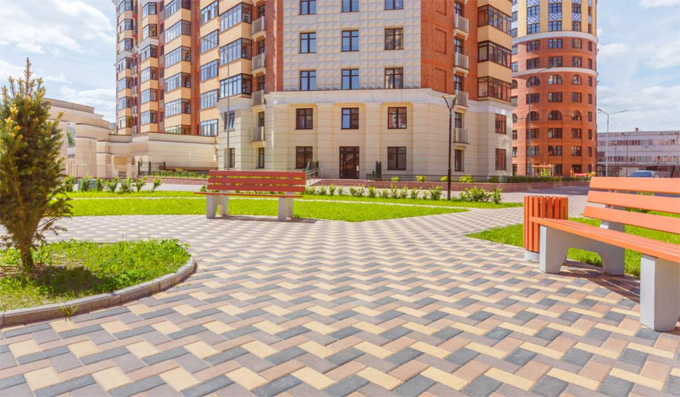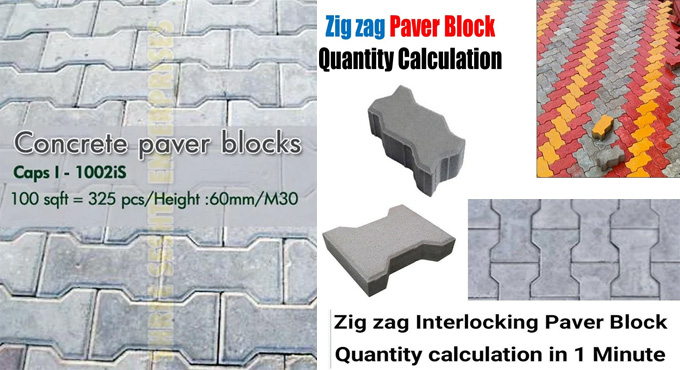
What is the Process of Paver Block Area Calculation

The paving blocks refer to the small and flat blocks that have been used to construct pavements. To construct the paving blocks, a right proportion of cement, sand and stones is required. The materials used in the paving blocks are interlocked seamlessly, which helps to make them strong, and there is less chance of breakage of the paving blocks. The paving blocks help to provide aesthetic visuals at a lower maintenance cost, which leads to their wide use in exterior pavement applications.

Discuss the different types of paving blocks
The paving blocks are available in different sizes and shapes because they are made up of different types of materials.
Clay paver block
These types of paving blocks are available in natural shade and have been used to construct the pillars and walls.
Plastic paver blocks
In this case, recycled waste plastics have been used, which helps to reduce the unwanted plastic waste and makes it environmentally friendly.
Concrete paver blocks
These types of paving blocks have been used in pavement construction to support heavy loads.
Rubber paver blocks
The recycled rubber has been used to make this type of paving block, which has been used in the outdoor patio floor covering, playground flooring, pool decking or floor decking. In the rubber paver blocks, different colours of pigments have been added, which help to improve the appearance of the paver blocks.
Stone paver blocks
Natural stones have been used, curved and cut to make this type of paving block.
Regular paver blocks
These types of paving blocks have been used in the parking areas, basements, or footpaths and other areas, in which the human traffic is high.
Permeable paver blocks
These types of paving blocks have been used to drain the water and installed in the garden areas, pathways or backyards.
Process of making paving blocks
The pavers have been made in different thicknesses, with the help of the paver-block making machines. The pavers are made with one or two layers, in which the top layer has been made with marble powder, white cement, marble granules, and colour pigments; whereas, the bottom layers have been made with sand, cement, and coarse aggregate. These layers help to provide heavy strength to the paving blocks.
Advantages of using paving blocks in construction work
Easy to install
In the case of installing the paving block, no expensive machinery or processes are required, thus it is easy to install. The installation procedure is also economical and time-effective.
Long-term durable
The paving blocks have the ability to resist heavy traffic and extreme weather conditions. The interlocking system in the paving blocks helps to make it strong by adding strength to it, which influences the long-term durability of the paving blocks.
Eco-freindly
The recycled materials have been used to make the pavers, which are sustainable for the long term and eco-friendly. The pores present in the pavers help to pass the rainwater, thus reducing the chance of waterlogging in the roads and preventing the risk of flooding in the urban water bodies.
Customisable
The pavong blocks can be available in many colours, shapes and sizes, which helps to make aesthetically appealing roads. The paving blocks also have the ability to blend with the surrounding environment, which enables urban planners to design roads with aesthetic visuals.
Cost-effecitve
The materials used in the paving blocks, for example, concrete and asphalt, are easily available and cheap, which makes the whole system cost-effective. In the case of damaging one paving block, it can be replaced with another and does not require any expensive repair process.
Load-bearing capability
The paving blocks have the ability to resist the load of heavy vehicles and machinery. The surface of the paving blocks remains intact during the heady traffic conditions, which shows its high load-bearing capacity.
Improving safety
The paving blocks help to provide a strong grip, which is safe for walking or driving even in wet conditions. In this context, the paving blocks have been installed on the high-traffic roads and bike lanes.
Concept about the paving blocks estimate
The paving blocks estimate indicates the process of measuring the quantity of materials and the overall cost for the construction of the paving blocks. It is important to estimate the paving blocks for the construction of specific areas, including patios, walkways or driveways.
Discuss the measuring areas for the pavers
Calculating the patio area
At first, the length and width of the patio area need to be estimated in meters or feet. In this context, a measuring tape or measuring wheel is required to get precise measurements for the length and width. After measuring, the amount should be recorded.
Measuring wastes
While cutting and adjusting the paving blocks, the waste factor should also be included in the total area. In this context, the estimated area should be multiplied by the waste factor and added to the total area.
To learn more, watch the following video tutorial.
Video Source: Ian Construction
Selecting the pave size
After determining the waste factors, the size and style of the pavers also need to be selected for the patio on the basis of the design preferences.
Estimating the paver quantity
In this step, the total area with waste has been divided by the area that has been covered by a single paver, which helps to get the exact number of pavers that have been required in that construction project.
Round up
The paving blocks have been sold in whole numbers. In this context, the calculated number of paving blocks should be rounded up to the nearest whole number, on the basis of the requirements for sold out.
Double-check the estimating process
The entire calculation should be double-checked before making the final purchase. In this context, a few extra pavers need to be ordered in the case of replacement in the future.


